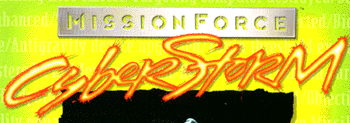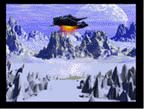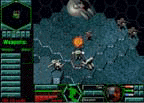

Mission Force: Cyberstorm
Review by Al Giovetti, 09/01/96
Genre: Strategy
Price: $60
Release: June 1996
Developer: Sierra Online
Art:
Music:
Programmer:
Producer:
Phone: 800-757-7707
Designer: Sierra Online, 3380 146th Place SE, Suite 300, Bellevue, WA 98007, 800-757-7707
Web Site: www.sierra.com/games/cyberstorm
Platform: Windows 95
Required: 486-50 MHz, 8MB RAM, Win 95, 40 - 360 MB hard disk space, Super VGA 640x480, MS compatible mouse
Overall: Nice, turn-based strategy game with some flaws and some really nice features. Complex game play makes this one addictive and fun, for hundreds of hours of enjoyment. My son was gripped by it for a week. Although he now is back to playing Warlords 2, I believe he will be going back to Cyberstorn again and again.
Those who do not study history are doomed to repeat the mistakes of the past. Many of the games of the present fail because they also failed to heed these words. Mission Force does not make the same mistake, and benefits from both board games and pre-multimedia computer games that are fun to play. There is a blending here of the resource management necessary for any combat game, the tactical, and strategic game play. You have a choice of missions which gives you control of how well prepared your men are for the next encounter or to go right into the conquest of the controlling planet of the three systems you are after.
Mission Force: Cyberstorm and EarthSiege 1 and 2 borrow heavily from other products in this genre. It is the far future, the 27th century, and man has run afoul of Terminator-like, sentient, machine creatures called Cybrids who seek the extermination of the human race. The Cybrids creatures and the human race fight in 10- to 100-ton armored, humanoid, BattleTech/MechWarrior-like robot warriors called Hercs, which come in many different types and can be equipped with multiple beam weapons, Gatling guns, automatic cannon, and missile systems.
Cyberstorm is set some time after the two EarthSiege products. The
Cybrids have moved from their moon base into the cosmos and are now
fighting for the entire universe on a planet-to-planet battlefield.
Fighting the Cybrids are mercenary units protecting the far flung mining
operations of an earth which exploits the resources of space to support
their earth-bound civilization. In MissionForce, the pilots of the
Hercs are clone-like Bioderms, constructed from the genetic material of
former human heroes.

Both the humans and enemy have eight vehicles each, beautifully rendered, 3D robots, which can be equipped with a large variety of cannon, missiles, beam weapons, shield, armor, and other devices. The sheer number of customization opportunities may overwhelm some, but it forms the basis for the strategic battle of knowing which device to use under what circumstances to defeat the enemy.
There are thirteen separate levels of command in the campaign game, which can be fought from the beginning or entered at any level from the quick start save games on the CD. In the beginning you command up to three Hercs and three Bioderms. As missions get more and more challenging you increase in rank through 14 stages, from Ensign to Herc Commander, where you can command up to 28 Hercs and 40 Bioderms. You are a mercinary in charge of a mercinary unit. Turn a profit and you survive to fight another day. Fail on enough missions and show sufficient losses and the powers that be remove you from your position.
Success in the campaign game increases the number, quality, and quantity of Hercs, Bioderms, weapons, and equipment, finally giving access to all eight Herc types and hundreds of types of equipment. More and more credits are obtained by mining the ore, destroying and salvaging Cybrids, and by successfully completing the mission for a mission bonus. Credits are used for repair, purchase, and upgrade of Hercs and Bioderms. Hercs can be configured from the eight basic chasses with any weapons, armor, and equipment that you desire, making a game within a game.
The interface is composed of two places, the battlefield and the base menu. The base menu allows for the selection, repair, and outfitting of Hercs and Bioderms, and mission selection. The base has traditional menus composed of words and can be activated simply and conveniently by clicking on the station or building that houses the function needed. Clicking on these locations was easier and quicker than using the traditional highlighted word menus.
The battlefield interface shows a zoomable and rotatable overhead map in
the upper left hand corner of the screen. The bottom left hand section
of the screen has four optional displays, including move, fire,
internal, and shields. In offensive mode the firing menu is important,
while in defensive mode it is important to keep the strongest shields
pointed to the enemy. Hot key equivalents to these menu based mouse
commands would have made gameplay more convenient.

The main screen viewing area shows a close-up, overhead map view of the battlefield in the upper right hand corner of the screen. Below the main display is a readout of Cybrid shields, damage, energy levels and Bioderm health, stamina, and toxin level in graphic format and bar graphs. The menu can be used to cycle through the available Hercs, giving them commands to explore, shoot, fire, and mine ore.
All battlefields are divided into hexes, hex-shaped movement squares. All battlefields are six-sided with 33 hexes on each side. The location of buildings and Cybrids and the terrain are generated randomly with the software-based mission generator, and while you never fight the same battles twice, the battles are remarkably similar once you begin to understand how the program works. You can predict what Cybrids will be pitted against you, once you know that the bonus in credits will be.
There is an interesting interplay between weapons and defense systems. Certain beam weapons will destroy shields but will not affect armor. Certain other weapons, including projectiles, will penetrate armor but do nothing to shields. Many planetary environments favor certain types of equipment an impede or prevent others from functioning. An effective game plan requires knowledge of the advantages and limitations of all types of equipment in all types of situations, making this incredibly detailed sim more enjoyable.
The fog of war is simulated by leaving unexplored areas dark and limiting exploration and combat to line of sight save with certain types of projectiles. Once explored, areas are easily viewed by your hercs even if they are out of range, line of site or vision.
One tactical feature of all rock-em-sock-em robot products is the ability to target body parts for a leg shot or head kill. Cyberstorm only permits the targetting of the mech and there is no selection or distinction as to parts. Shooting parts is essential to the details involved in salvage and reconstruction of mechs captured in battle, which is also not simulated in the game.
The Super VGA graphics show light-sourced, texture-mapped, 3D graphics for the terrain and robots. Excellent animation marks the cut scenes and the menu selection areas. But basic gameplay does not give you the same kind of in-your-face action graphics as seen in Mechwarrior 1 or 2 or EarthSiege 1 or 2.
Up to eight people can play on a local area network (IPX and TCP/IP) or head-to-head via null or phone modem. Network play can be with or without Cybrids, as teams of players against one another, as a free-for-all with each fighting all the other players, and as Humans vs. Cybrids working as teams. The options for multiple players are extensive, with even an extra disk to give to a friend. Other game companies should take note.
The lack of a paper manual, which is more easy to browse and read at leisure, is a real problem. The manual is printable, but the printouts are in extremely hard-to-read, light gray text, requiring you to change the system printer settings to get readable text. And while this is good, printouts are harder to read than books.
The learning curve is steep in the beginning of the campaign game, and many will be frustrated when their Hercs are destroyed and Bioderms killed. Using the three difficulty levels may help many get started and develop a game plan early on. Understanding of the weapons and equipment advantages and disadvantages takes time, but many will agree that this is what makes the game fun.
Hints: Pay attention to what weapons take down shields, damage both machine and shields, and damage machine only. Fire weapons that take shields down first. This will require you to make several circuits of the available Hercs, but it will be worth it when out-gunned or out-numbered. Since the weapons that cannot penetrate shields are only effective when the shields are down, do not fire them until this happens.
Targeting an enemy with shields down on one hex side will let you maneuver your Herc into position where firing through that hexside is achieved. Obviously, firing through the side without shields will kill the opposition with less ordnance.
Reviewers: The game is universally loved by reviewers and gamers alike.
References
Shane Mooney, PC Games, August, 1996, volume 3, Number 8, pages, 56 -
57, A- (92%)
Jeff Gilbert, InterAction, Summer, 1996, pg. 28-31.
E. Chin, Computer Gaming World, number 146, September, 1996, pg. 38, hot
(100%).
Trent C. Ward, http://www.gamespot.com/strategy/cybersto, (89%).
http://www.cnet.com/Gamecenter/Reviews/Cyberstorm/
Peter Smith, Computer Games Strategy Plus, issue 71, October, 1996, pg.
72-74, 4/5, (80%-90%).
Strategy references
Shane Mooney, PC Games, August, 1996, volume 3, Number 8, pages 82.